
The clown triggerfish, also known as the bigspotted triggerfish, is a demersal marine fish.

Gouramis, or gouramies, are a group of freshwater anabantiform fish that comprise the family Osphronemidae. The fish are native to Asia—from the Indian Subcontinent to Southeast Asia and northeasterly towards Korea. The name "gourami", of Indonesian origin, is also used for fish of the families Helostomatidae and Anabantidae.
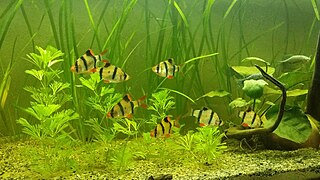
The tiger barb or Sumatra barb, is a species of tropical cyprinid fish. The natural geographic range reportedly extends throughout the Malay Peninsula, Sumatra and Borneo in Indonesia, with unsubstantiated sightings reported in Cambodia. Tiger barbs are also found in many other parts of Asia, and with little reliable collection data over long periods of time, definite conclusions about their natural geographic range versus established introductions are difficult. Tiger barbs may sometimes be confused with Puntigrus anchisporus, Puntigrus navjotsodhii, or Puntigrus partipentazona, which are similar in appearance, the only differences being the slightly different stripe pattern and the number of scales these fish have.
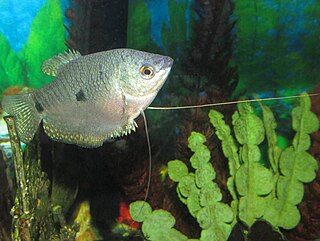
The three spot gourami, also known as the opaline gourami, blue gourami, and gold gourami, is a species of fish native to southeastern Asia, but also introduced elsewhere. This gourami gets its name from the two spots along each side of its body in line with the eye, considered the third spot. This species is of minor commercial importance as a food fish in its native range and is also farmed. It is also popular in the aquarium trade. The species reaches 15 cm in standard length.

The fork tailed paradisefish, or paradise gourami is a species of gourami found in most types of fresh water in East Asia, ranging from the China to northern Vietnam. This species can reach a standard length of 6.7 cm, though most are only about 5.5 cm . Paradise gouramis were one of the first ornamental fish available to western aquarium keepers, having been imported 1869 to France by the French aquarium fish importer Pierre Carbonnier in Paris. The paradise fish is one of the more aggressive members of its family. It is more aggressive than the three spot gourami, yet less pugnacious in nature than the less commonly kept combtail.

The red-tailed black shark, also known as the redtail shark, red tailed shark, and redtail sharkminnow, is a species of tropical freshwater fish in the carp family, Cyprinidae. It’s named after its shark like appearance and movement, as well as its distinctive red tail. Despite its name, it is more closely related to carp. It is endemic to streams and rivers in Thailand and is currently critically endangered. However, it is common in aquaria, where it is prized for its deep black body, and vivid red orange tail. These are moderately sized tropical aquarium fish who are active benthic swimmers. They are omnivorous but are willing to scavenge if the opportunity arises. They are known for their activity as well as their temperament towards other fish. The red-tailed black sharks seen in the aquarium trade today are all captive bred.
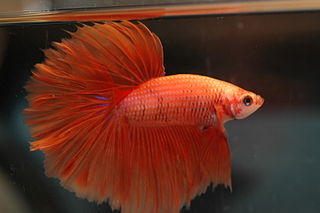
The Siamese fighting fish, commonly known as the betta, is a freshwater fish native to Southeast Asia, namely Cambodia, Laos, Myanmar, Malaysia, Indonesia, Thailand, and Vietnam. It is one of 76 species of the genus Betta, but the only one eponymously called "betta", owing to its global popularity as a pet; Betta splendens are among the most popular aquarium fish in the world, due to their diverse and colorful morphology and relatively low maintenance.
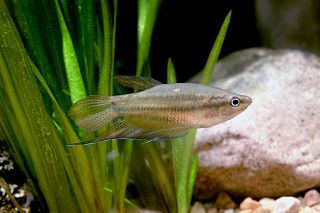
The croaking gourami is a species of small freshwater labyrinth fish of the gourami family. They are native to still waters in Southeast Asia and are distributed worldwide via the aquarium trade. Croaking gouramis are capable of producing a "croaking" noise using their pectoral fins.
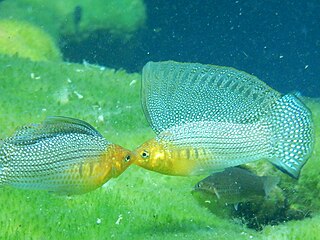
Poecilia velifera, known as the Yucatan molly and also as the giant sailfin molly amongst aquarists, is a large livebearer that lives in coastal waters of the Yucatan Peninsula. These live-bearer (Poeciliidae) fish are particularly well known for both the extreme size variation among males, and the sexual dimorphism between males and females in both body shape and behavior.
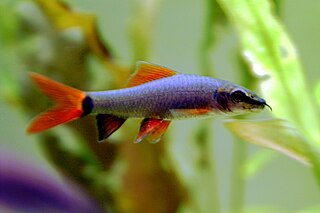
The rainbow shark is a species of Southeast Asian freshwater fish from the family Cyprinidae. It is also known as the ruby shark, red-fin shark, red-finned shark, rainbow sharkminnow, green fringelip labeo, whitefin shark and whitetail sharkminnow. It is a popular, semi-aggressive aquarium fish. Unlike true sharks, which belong to the Chondrichthyes lineage, the rainbow shark is an actinopterygiian.
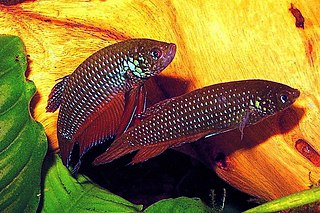
Betta smaragdina, commonly known as the emerald green betta, blue betta or Mekong fighting fish is a species of gourami native to Southeast Asia. The species gets its green and blue colors due to refraction and interference of light that results from hexagonal crystals that are less than 0.5 micrometres. It is found in the aquarium trade.
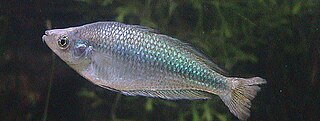
The Murray River rainbowfish, known less commonly as the Australian rainbowfish, is a species of freshwater fish endemic to southeastern Australia. The southernmost species of all rainbowfishes, these fish are very colourful, hence the name; and there is sexual dimorphism with the males being larger and more colourful than females. Murray River rainbowfish are schooling fish and will congregate near logs or riverbanks, and are a popular aquarium fish.

Betta pallifina is a species of gourami endemic to the island of Borneo.

The peaceful betta or crescent betta is a species of gourami native to Southeast Asia.
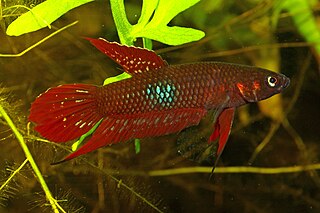
Betta coccina is a species of betta native to Peninsular Malaysia and Sumatra, Indonesia. It grows to a length of 5.6 cm (2.2 in). It can be found in the aquarium trade. Betta coccina, commonly known as the wine red betta or red fighting fish, is a species of freshwater fish in the family Osphronemidae. It is endemic to the peat swamps of Indonesia and Malaysia, where it inhabits acidic, slow-moving waters. The species is known for its striking red coloration and relatively peaceful temperament compared to other Betta species.

Betta balunga is a species of gourami endemic to the island of Borneo, and whose species name derives from the location where it was first described - the Balung River in Sabah, eastern Malaysia. It inhabits forest and blackwater streams, and grows to a length of 4.9 cm (1.9 in).
Betta gladiator is a species of gourami endemic to Sabah, Malaysia. It is an inhabitant of the acidic waters of heath forest. It is known as a particularly territorial and aggressive species, especially in captivity. This species grows to a length of 5.6 centimetres (2.2 in) SL and are facultative air-breathers.
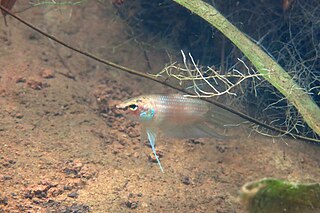
Betta ferox is a species of gourami endemic to Thailand. It is only found in rivers in Songkhla Province, where it resides along shallow riverbanks among vegetation. This species grows to a length of 6.3 centimetres (2.5 in) SL. This species is closely related to Betta pugnax and is also a paternal mouthbrooder. Males and females are dimorphic, with males displaying elongated ventral fins, elongated caudal fins, and green coloration on the gill plates. Females typically display two horizontal brown bars across their bodies, shorter fins, and a more rounded body shape.
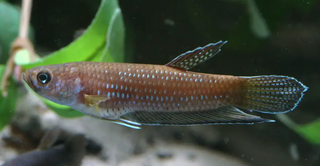
Betta antoni is a species of gourami endemic to the Sanggau area in the Kapuas region. The species name antoni is named after Irwan Anton "in recognition of his generous help and gift of specimens". This species grows to a length of 8 centimetres (3.1 in) SL. According to Linke, they live in "densely vegetated, narrow watercourses with very soft, very acidic water".

Betta pi is a species of gourami belonging to the genus Betta. It is found in the Pru Toe-Daeng peat swamps in Narathiwat Province in Southern Thailand, but its range also extends into northern Peninsular Malaysia, most notably the states of Kelantan and Terengganu. It is primarily found in well-shaded peat forest blackwater swamps and creeks where the pH can be as low as 3.0 or 4.0. It is benthopelagic. It can grow to a maximum length of 9.0 cm (3.5 in). It is a fish of mild importance in the aquarium industry. Its diet consists of aquatic invertebrates in the wild, but will also eat frozen, live and dried foods such as larva of Chironomidae, Daphnia, and brine shrimp in aquariums.



















